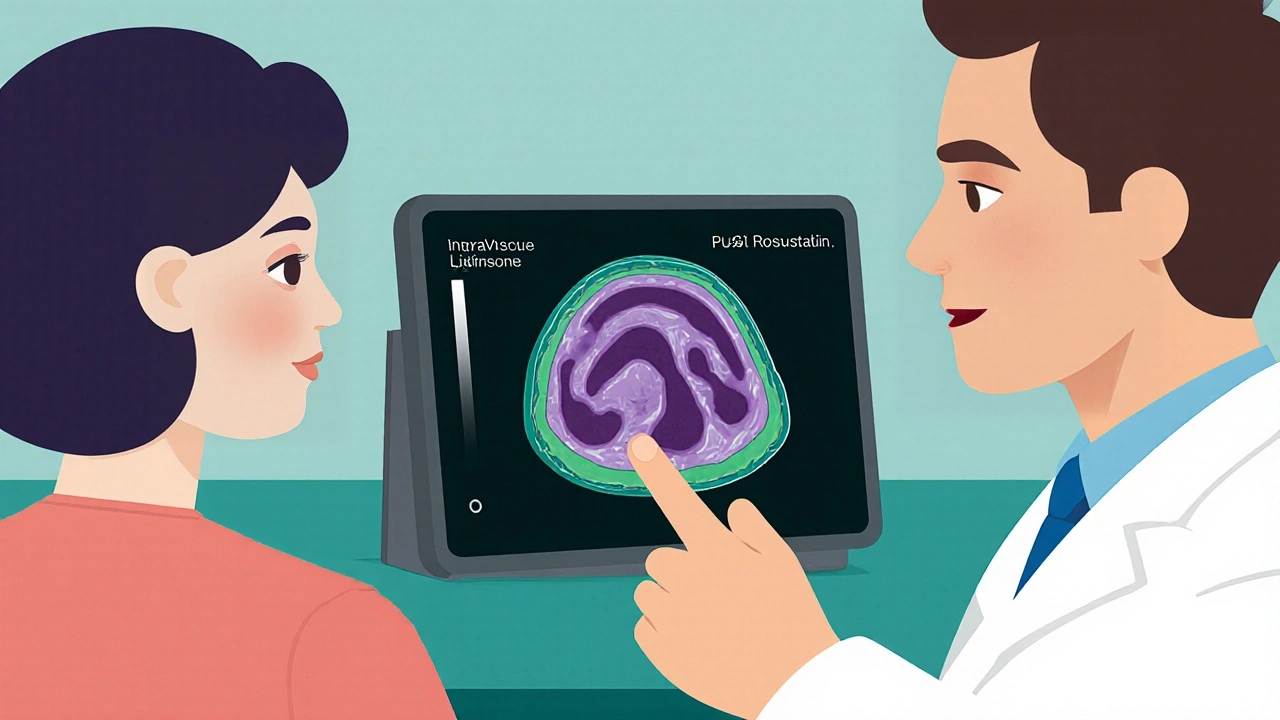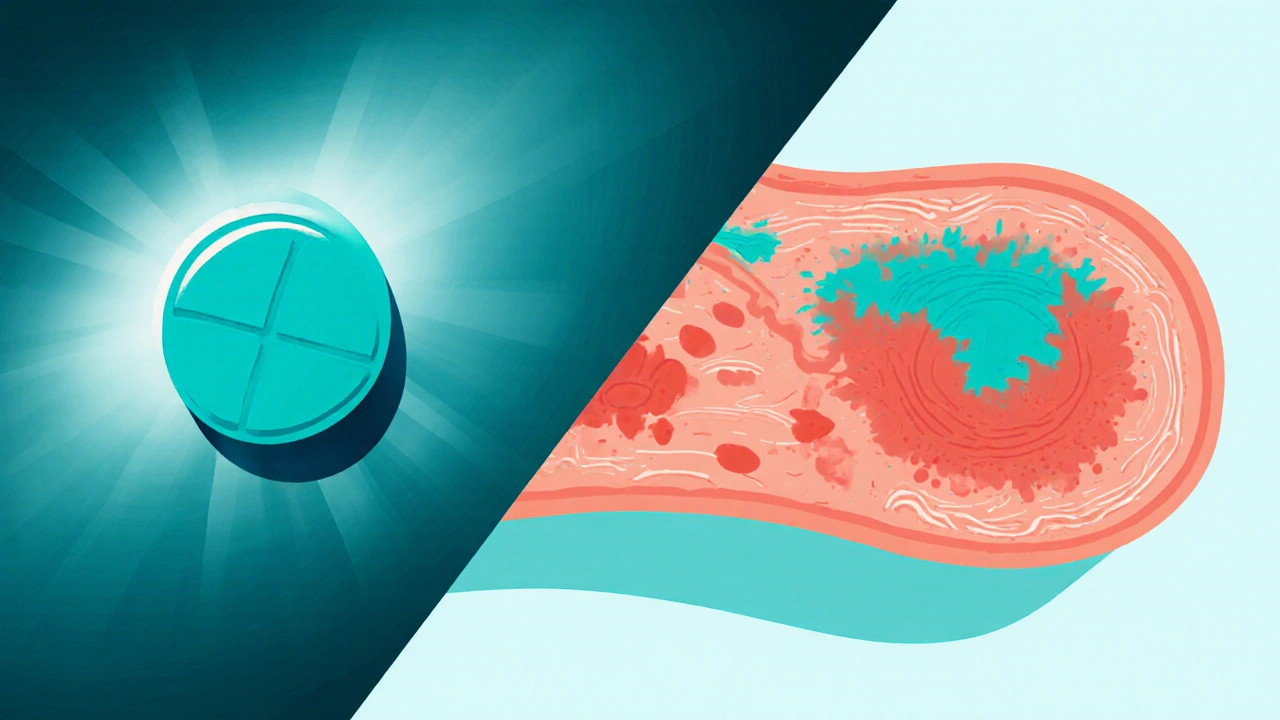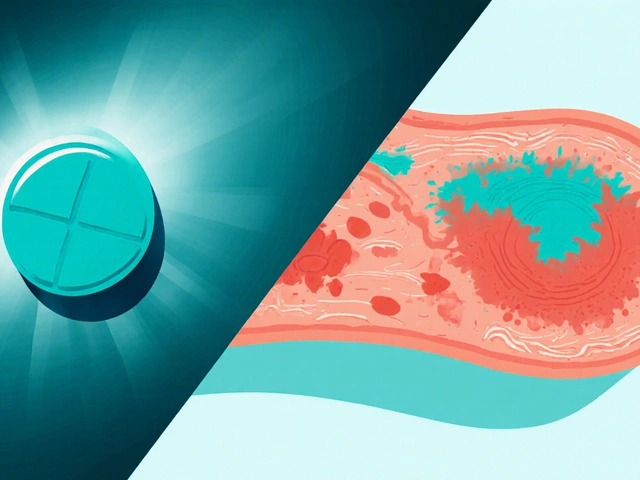Rosuvastatin CRP Reduction Calculator
Estimate your potential C-reactive protein (CRP) reduction and cardiovascular risk reduction based on your baseline CRP levels and rosuvastatin dose. The JUPITER trial showed a 44% reduction in major cardiovascular events among participants with elevated CRP.
Note: These are estimated values based on clinical data. Individual results may vary due to genetic factors, other medications, and lifestyle factors.
Quick Takeaways
- Rosuvastatin lowers LDL cholesterol and also reduces markers of systemic inflammation such as C‑reactive protein (CRP).
- The anti‑inflammatory effect is linked to its ability to inhibit HMG‑CoA reductase, which modulates downstream inflammatory pathways.
- Clinical trials show modest CRP reductions (10‑30%) that translate into lower cardiovascular event rates.
- Not all patients experience the same benefit; genetics, dose, and concurrent therapies matter.
- Potential side effects-muscle pain, liver enzyme rise-should be balanced against the dual cholesterol‑and‑inflammation payoff.
When you hear the name Rosuvastatin is a synthetic, high‑potency statin that blocks the enzyme HMG‑CoA reductase, dramatically lowering low‑density lipoprotein (LDL) cholesterol. But the drug does more than just clean up your blood‑fat profile; it also tampers with the body’s inflammatory response, a factor that underlies atherosclerosis and many chronic diseases.
Understanding the link between rosuvastatin and inflammation helps you ask the right questions at the doctor’s office and decide whether the medication fits your health goals.
Why Inflammation Matters in Heart Health
Inflammation is the immune system’s alarm system. When it runs unchecked, it can damage blood‑vessel walls, promote plaque formation, and destabilize existing plaques. A widely used marker for systemic inflammation is C‑reactive protein (CRP). Elevated CRP levels are correlated with a higher risk of heart attacks, strokes, and peripheral artery disease.
Statins as Anti‑Inflammatory Agents
All statins share the primary goal of reducing LDL cholesterol, but many also lower CRP. The underlying mechanism involves reduced production of mevalonate‑derived isoprenoids, which are essential for the activation of inflammatory cells such as macrophages. By cutting off this supply chain, statins blunt the inflammatory cascade.
Rosuvastatin’s Specific Anti‑Inflammatory Profile
Compared with older statins like simvastatin or pravastatin, rosuvastatin demonstrates a stronger LDL‑lowering effect at lower doses. This potency seems to extend to inflammation as well.
- CRP Reduction: Meta‑analyses of randomized controlled trials (RCTs) report an average CRP drop of 15‑25% after 12 weeks of rosuvastatin 10‑20 mg daily.
- Plaque Stabilization: Imaging studies using intravascular ultrasound show decreased lipid‑rich core size in patients on rosuvastatin, implying a less inflamed plaque environment.
- Outcome Benefit: The JUPITER trial, although centered on rosuvastatin 20 mg, demonstrated a 44% reduction in major cardiovascular events among participants with baseline CRP ≥ 2 mg/L despite normal LDL levels.
These findings suggest that rosuvastatin’s impact on inflammation isn’t just a side‑effect; it’s a therapeutic lever that contributes to cardiovascular risk reduction.

How Dose Influences Both Cholesterol and Inflammation
Rosuvastatin’s dose‑response curve is steep. A 5 mg dose may lower LDL by ~30%, while a 20 mg dose can achieve >50% reduction. The anti‑inflammatory response mirrors this pattern but with a slightly delayed onset-CRP often continues to fall for up to 24 weeks at higher doses.
Patients with high baseline CRP tend to see the biggest relative reductions, especially when the LDL‑lowering goal is already met. This “dual‑target” approach (LDL < 70 mg/dL AND CRP < 2 mg/L) is now recommended in several European guidelines for very high‑risk individuals.
Key Clinical Trials Linking Rosuvastatin to Inflammation
| Trial | Population | Dose (mg) | CRP Change | Main Outcome |
|---|---|---|---|---|
| JUPITER (2008) | Patients with CRP ≥ 2 mg/L, LDL < 130 mg/dL | 20 | −37% | 44% ↓ in major CV events |
| STELLAR (2015) | Hyperlipidemic adults, mixed risk | 10‑20 | −15% (10 mg) / −23% (20 mg) | Improved plaque composition |
| METEOR (2021) | Patients post‑acute coronary syndrome | 10 | −18% | Reduced recurrent MI |
Potential Side Effects to Keep in Mind
While rosuvastatin’s inflammation benefits are compelling, the drug isn’t without risks. Commonly reported adverse events include:
- Myalgia or muscle weakness (≈5% of users)
- Elevated liver enzymes (ALT/AST) in 1‑2% of patients
- Rare cases of rhabdomyolysis, especially at doses >40 mg or when combined with certain antifungals
Because inflammation itself can raise CRP, an acute infection may temporarily mask rosuvastatin’s effect. If you notice a sudden CRP spike while on therapy, check for infection rather than assuming the drug stopped working.
Practical Tips for Patients and Clinicians
- Baseline Testing: Measure LDL, total cholesterol, and high‑sensitivity CRP (hs‑CRP) before starting therapy.
- Start Low, Go Slow: Many clinicians begin with 5 mg daily, titrating up based on LDL and CRP goals.
- Monitor Periodically: Re‑check labs at 6‑week intervals for the first three doses, then every 6‑12 months.
- Assess Lifestyle: Diet, exercise, and smoking cessation independently lower CRP and amplify rosuvastatin’s benefit.
- Watch for Interactions: Avoid concurrent high‑dose niacin, potent CYP3A4 inhibitors, and certain antibiotics that increase statin levels.

When Rosuvastatin Might Not Be the Best Choice
If you have a history of severe statin intolerance, a genetic variation in the SLCO1B1 transporter, or chronic liver disease, your doctor may opt for a different statin (e.g., pravastatin) or a non‑statin lipid‑lowering agent like ezetimibe. In such cases, the anti‑inflammatory advantage could be lost, so discuss alternative ways to lower CRP-like omega‑3 fatty acids or anti‑inflammatory diets.
Future Directions: Beyond Lipids
Researchers are now exploring rosuvastatin’s role in non‑cardiovascular inflammatory conditions, such as rheumatoid arthritis and chronic obstructive pulmonary disease (COPD). Early phase‑2 trials hint at modest symptom relief, but larger studies are needed before prescribing rosuvastatin for these indications.
Bottom Line
Rosuvastatin isn’t just a cholesterol‑cutting pill; it’s a double‑action agent that can lower systemic inflammation, mainly measured by CRP. The effect, though modest compared with its lipid‑lowering power, contributes to a measurable drop in heart attacks and strokes, especially for people who start with high CRP levels. Weigh the benefits against possible side effects, keep an eye on lab results, and pair the medication with a heart‑healthy lifestyle for the best outcome.
Frequently Asked Questions
Can rosuvastatin lower CRP even if my LDL is already normal?
Yes. The JUPITER trial enrolled participants with LDL < 130 mg/dL but CRP ≥ 2 mg/L, and rosuvastatin 20 mg reduced both CRP and cardiovascular events. The drug’s anti‑inflammatory action works independently of LDL‑lowering.
How long does it take to see a drop in CRP after starting rosuvastatin?
CRP typically begins to decline within 4‑6 weeks. Full plateau may take up to 24 weeks, especially at higher doses.
Do I need a special blood test to monitor inflammation?
A high‑sensitivity CRP (hs‑CRP) test is the standard. It detects low‑grade inflammation and is more precise than the standard CRP assay.
Are there any foods that interfere with rosuvastatin’s anti‑inflammatory effect?
Heavy alcohol intake and diets high in saturated fat can blunt the CRP‑lowering benefit. A Mediterranean‑style diet rich in fruits, vegetables, and omega‑3 fish oils supports both lipid and inflammation control.
What should I do if I experience muscle pain while on rosuvastatin?
Report the symptom to your clinician promptly. They may lower the dose, switch to a different statin, or order a CK (creatine kinase) test to rule out serious muscle injury.



Liberty Moneybomb
October 18, 2025 at 13:24The pharma elite don’t want you to know this!
Alex Lineses
October 19, 2025 at 17:16Great point about the hidden angles-if you dig into the mechanism, rosuvastatin’s inhibition of HMG‑CoA reductase not only slashes LDL but also dampens mevalonate pathway signaling. That downstream effect curtails isoprenoid synthesis, which modulates macrophage activation and CRP production. Clinical data from JUPITER and METEOR reinforce that the anti‑inflammatory cascade is real and quantifiable. So, while skeptics chatter, the evidence base actually lines up nicely with the pharmacology.
Brian Van Horne
October 20, 2025 at 21:20Rosuvastatin’s dual action on lipids and CRP is well-documented in peer‑reviewed trials.
Karla Johnson
October 22, 2025 at 01:23When you consider the totality of evidence, the picture that emerges about rosuvastatin’s anti‑inflammatory capacity is nothing short of compelling. The JUPITER trial, originally designed to target patients with elevated hs‑CRP despite near‑normal LDL, demonstrated a 44 % reduction in major cardiovascular events, underscoring that CRP lowering translates into hard outcomes. Moreover, the dose‑response relationship is evident; higher doses such as 20 mg achieve a roughly 35‑40 % drop in CRP, while modest 5 mg regimens still produce meaningful reductions of about 10‑15 %. Mechanistically, by attenuating mevalonate‑derived isoprenoids, rosuvastatin impairs the prenylation of small GTPases, which are critical for macrophage chemotaxis and cytokine release. This biochemical blockade results in reduced NF‑κB activation, a master regulator of inflammatory gene expression, thereby lowering systemic markers like CRP and IL‑6. Imaging studies using intravascular ultrasound have shown that plaques in rosuvastatin‑treated patients become less lipid‑rich and more fibrous, a hallmark of a stabilized, less inflamed lesion. Patients with baseline CRP levels above 2 mg/L reap the greatest incremental benefit, suggesting that the drug’s anti‑inflammatory effect is most pronounced where inflammation is already high. Importantly, these benefits are observed even when LDL targets are already met, indicating an independent pathway beyond mere cholesterol reduction. Real‑world cohorts mirror trial data: clinicians report fewer recurrent myocardial infarctions in high‑risk groups on rosuvastatin versus other statins with comparable LDL lowering. Nevertheless, the therapy is not without caveats; muscle‑related adverse events occur in roughly 5 % of users and require vigilant monitoring. Liver enzyme elevations, while less frequent, must also be checked periodically, especially when patients consume alcohol or hepatotoxic medications. Genetic polymorphisms in the SLCO1B1 transporter can predispose certain individuals to higher plasma concentrations, amplifying both efficacy and toxicity. Thus, a personalized approach-starting low, assessing CRP trends, and titrating dose-optimizes the risk‑benefit balance. Lifestyle interventions, such as a Mediterranean diet rich in omega‑3 fatty acids, synergize with rosuvastatin to further depress CRP levels. In summary, rosuvastatin stands out as a powerful dual‑action agent, and when wielded judiciously, its anti‑inflammatory properties can be a decisive factor in preventing cardiovascular events.
Ayla Stewart
October 23, 2025 at 05:26Rosuvastatin does more than just cut cholesterol; it also brings CRP down, which can help keep arteries healthier.
Poornima Ganesan
October 24, 2025 at 09:30While the quick takeaways are useful, the depth matters. The study you cited actually shows a dose‑dependent CRP drop, not just a flat “10‑30%” range. Also, remember that lifestyle factors can confound CRP measurements, so the drug’s effect isn’t isolated. Genetic variants in SLCO1B1 can change how patients respond, which you didn’t mention. Bottom line: a nuanced view is essential.
Mike Hamilton
October 25, 2025 at 13:33Hey folks, rosuvastatin is like a cultural bridge - it connects the science of lipids with the art of daily health. Its power comes from blocking HMG‑CoA reductase, which then chills out the inflammation pathways. If you keep an eye on liver numbers and muscle aches, you can enjoy the benefits. Also, try to pair it with good food, not just pills!.
James Mali
October 26, 2025 at 16:36Sounds solid, but watch those muscles.
Rajesh Singh
October 27, 2025 at 20:40It is morally imperative to consider the whole patient, not just the numbers. A drug that lowers both LDL and CRP can be a boon for public health, provided we monitor side effects diligently. Ignoring the inflammation angle would be a disservice to those at highest risk.
Albert Fernàndez Chacón
October 29, 2025 at 00:43Exactly, and if you throw in a Mediterranean diet, the CRP drops even faster. From a clinical standpoint, the hs‑CRP trend is a practical marker to titrate the dose. So keep the labs tight and the lifestyle tighter.
Drew Waggoner
October 30, 2025 at 04:46Rosuvastatin’s anti‑inflammatory claim is interesting but often overstated.
Matthew Miller
October 31, 2025 at 08:50Let’s get pumped! 🚀 When you pair rosuvastatin with a high‑energy workout routine and vibrant veggies, you’re basically turbo‑charging your heart’s defenses. The science backs it – lower CRP means fewer flare‑ups, and you’ll feel the difference in your stamina. Keep the momentum, and watch those numbers swoosh down!
Joe Moore
November 1, 2025 at 12:53Yo, i heard that big pharma hide the real side effects of rosuvastatin so they can keep makin money off us. they dont want us to know that it can mess with your hormones long term. stay woke and ask your doc why they push this pill on everyone.
Emma Williams
November 2, 2025 at 16:56True point thanks
Stephanie Zaragoza
November 3, 2025 at 21:00While the enthusiasm for rosuvastatin’s dual benefits is commendable, one must not overlook the statistical nuances; the confidence intervals in many of the cited trials are relatively wide, and the absolute risk reduction, albeit clinically meaningful, is modest. Moreover, the potential for myalgia and transaminitis, albeit low, necessitates vigilant monitoring, especially in patients with polypharmacy. In addition, the heterogeneity of study populations-varying baseline CRP levels, differing concomitant therapies, and diverse genetic backgrounds-complicates the extrapolation of results to the general population. Therefore, prescribing rosuvastatin solely for its anti‑inflammatory effect without a clear lipid indication may be premature; a balanced, individualized approach remains paramount.